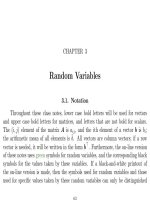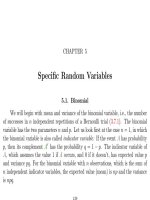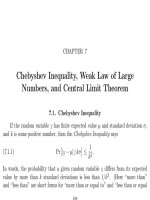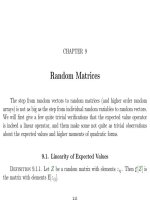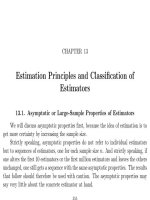ENGINEERING CHEMISTRY CLASS NOTES
Bạn đang xem bản rút gọn của tài liệu. Xem và tải ngay bản đầy đủ của tài liệu tại đây (1.03 MB, 160 trang )
Sri Shridevi Charitable Trust( R )
SHRIDEVI INSTITUTE OF ENGINEERING
AND TECHNOLOGY, TUMKUR-572106
ENGINEERING CHEMISTRY
CLASS NOTES
NAME
:____________________
USN
:____________________
BRANCH : ____________________
SECTION : ____________________
1. Dr. CHANDRASEKHAR. N
H.O.D of chemistry
2. Miss. SUJATHA.K
3. Miss. SHWETHA S. RAO
SHRIDEVI INSTITUTE OF ENGINEERING AND TECHNOLOGY.
CONTENTS
UNIT
PAGE
NO
TITLE
I
CHEMICAL ENERGY SOURCES
04-24
II
ELECTROCHEMICAL
SYSTEMS
25-43
III
CONVERSION AND STORAGE
ELECTROCHEMICAL ENERGY
IV
CORROSION SCIENCE
57-71
V
METAL FINISHING
72-84
VI
LIQUID
CRYSTALS
APPLICATIONS
VII
HIGH POLYMERS
VIII
WATER TECHNOLOGY
116-132
MODEL QUESTION PAPER
133-140
IX
ENERGY
AND
OF
THEIR
ENGINEERING CHEMISTRY DEPARTMENT, S.I.E.T., TUMKUR.
44-56
85-98
99-115
1
SHRIDEVI INSTITUTE OF ENGINEERING AND TECHNOLOGY.
Syllabus
PART A
Unit - I
Electrode Potential and Cells
Introduction, Differentiation between galvanic and electrolytic cells,
Construction of galvanic cell, EMF of a cell , Origin of single electrode
potential, Sign convention and cell notation, Standard electrode
potential, Derivation of Nernst equation for single electrode potential.
Types of electrodes: Reference electrodes – Primary and secondary ,
Limitations of standard hydrogen electrode, Construction and working of
calomel electrode and Ag – AgCl electrode, Measurement of single
electrode potential, Numerical problems on electrode potential and EMF
of a cell, Ion selective electrode: Glass electrode – Construction ,
Determination of pH of a solution using glass electrode.
7 Hours
Unit - II
Batteries and Fuel Cells
Basic concepts, Battery characteristics, primary, secondary, reserve
batteries and super capacitors with examples.
Classical batteries: Construction, working and applications of Zn – MnO2
battery, Lead acid storage battery and Ni – Cd battery.
Modern batteries: Construction and working and applications of Zn – air,
Ni – metal hydride and
Li – MnO2 batteries
Fuel cells – Differences between battery and fuel cell, construction and
working of H2 – O2 and
CH3OH– O2 fuel cells
6 Hours
Unit - III
Corrosion and its control
Electrochemical theory of corrosion, Galvanic series, Types of corrosionDifferential metal corrosion, Differential aeration corrosion(Pitting and
water line corrosion) , Stress corrosion (caustic embrittlement in boilers),
Factors affecting the rate of corrosion.
Corrosion control: Inorganic coatings – Anodizing and phosphating,
Organic coating – painting,
Metal coatings – Galvanizing and Tinning, Corrosion inhibitors, Cathodic
protection.
7 Hours
Unit – IV
ENGINEERING CHEMISTRY DEPARTMENT, S.I.E.T., TUMKUR.
2
SHRIDEVI INSTITUTE OF ENGINEERING AND TECHNOLOGY.
Metal Finishing
Technological importance, Theory of electroplating, Significance of
Polarization, Decomposition potential and Overvoltage in electroplating.
Effect of plating variables on the nature of electrodeposit. Electroplating
process, Electroplating of Copper and Chromium.
Distinction
between
electroplating
and
electrolessplating,
Electolessplating of copper and nickel.
6 Hours
PART B
Unit - V
Chemical fuels and Photovoltaic cells
Introduction, Classification of chemical fuels, Calorific value – High and
Low calorific values, Determination of calorific value –solid or liquid fuel
using Bomb calorimeter, Gaseous fuel using Buoy’s
calorimeter,
Numerical problems.
Petroleum – Cracking by fluidized catalytic cracking process,
Reformation of petrol, Octane and Cetane numbers. Knocking –
mechanism and harmful effects. Antiknocking agents – TEL, Catalytic
converters – Principle and working, Unleaded petrol, Power alcohol and
Biodiesel.
Photovoltaic cells – Production of solar grade silicon, Doping of silicon,
Construction and working of photovoltaic cell, Advantages.
7 Hours
Unit - VI
The Phase rule and Instrumental methods of analysis
Statement of Gibb’s phase rule and explanation of the terms involved,
Phase diagram of one component system – water system, Condensed
phase rule , Phase diagram of two component system- Eutectic Pb – Ag
system and Fe – C system. Application – Desilverization of lead.
Instrumental methods of analysis- Theory , Instrumentation and
applications of Colorimetry, Potentiometry , Conductometry and Flame
photometry.
6 Hours
Unit - VII
Polymers
Types of polymerization – Addition and Condensation, Mechanism of
polymerization – Free radical mechanism taking ethylene as example.
ENGINEERING CHEMISTRY DEPARTMENT, S.I.E.T., TUMKUR.
3
SHRIDEVI INSTITUTE OF ENGINEERING AND TECHNOLOGY.
Glass transition temperature ( Tg) . Structure – property relationship.
Types of plastics – Thermosetting and thermoplastics. Compounding
resins to plastics, Manufacture of plastics by compression and injection
moulding, extrusion method.
Synthesis and applications of Teflon, PMMA, Polyurethane and Phenol –
formaldehyde resins.
Elastomers: Deficiencies of natural rubber, Vulcanization of rubber.
Synthesis and applications of Neoprene and Butyl rubber, Silicone
rubbers.
Adhesives: Synthesis and applications of epoxy resins.
Polymer composites - Synthesis and applications of Kevlar and Carbon
fibers.
Conducting polymers – Definition, Mechanism of conduction in
Polyacetylene and Polyaniline.
7 Hours
Unit - VIII
Water Chemistry
Impurities in water, Water analysis – Determination of different
constituents in water – Hardness, alkalinity, chloride , fluoride , nitrate ,
sulphate and dissolved oxygen by Winkler’s method. Numerical problems
on hardness and alkalinity.
Sewage – BOD and COD, Numerical problems, Sewage treatment.
Desalination of water – Reverse Osmosis and Electrodialysis
6 Hours
Text Books
1. A text book of Engineering Chemistry P.C. Jain and Monica Jain
Dhanpatrai Publications,
New Delhi.
2. Chemistry In Engineering and Technology
( Vol. 1 &2) J.C.
Kuriacose and J. Rajaram.
Reference Books
1. Principles of Physical Chemistry B.R. Puri , L.R.Sharma & M.S.
Pathania, S. Nagin chand and Co.
2. Text Book of Polymer Science F.W. Billmeyer John Wiley & Sons.
3. Corrosion Engineering M.G. Fontana Mc. Graw Hill Publications.
4. Environmental Chemistry Stanley E. Manahan , Lewis Publishers.
5. Polymer Science V.R. Gowariker , Wiley Eastern Ltd.
ENGINEERING CHEMISTRY DEPARTMENT, S.I.E.T., TUMKUR.
4
SHRIDEVI INSTITUTE OF ENGINEERING AND TECHNOLOGY.
U N IT – I
CHEMICAL ENERGY SOURCES:
FUELS
1.1 Define a fuel. Explain the classification of fuels with examples.
5 Marks
A fuel is defined as naturally occurring or artificially
manufactured combustible carbonaceous material which serves
particularly as source of heat and light and also in few cases as a source
of raw material.
Classification of fuels Fuels are classified into a two types.
1) Based on their origin they are classified into
a) Primary fuels
b) Secondary fuels.
a) Primary Fuels: There are naturally occurring fuels which serves as
source of energy without any chemical processing.
Ex: Wood, Coal, Crude oil, Natural gas, Peat, Lignite, Anthracite..
b) Secondary Fuels: - They are derived from primary fuels & serves as
source of energy only after subjecting to chemical processing.
Ex: Charcoal, Coke, produsergas, Petrol, Diesel etc.,
2) Bases on their physical state fuel are classified into
a) Solid
b) Liquid
c) Gaseous fuels.
SOLID
LIQUID
Primary Fuels
Wood,
Coal,
Crude oil
Peat, Anthracite
Secondary Fuels
Coke, Charcoal
GASEOUS
Natural gas.
LPG,
Petrol, Gasoline,
produsergas,
Diesel
Coal gas.
1.2 Define Calorific Value. Explain the types
04 Marks
Calorific value is defined as the amount of heat liberated when a
unit mass of fuel is burnt completely in presence of air or oxygen.
ENGINEERING CHEMISTRY DEPARTMENT, S.I.E.T., TUMKUR.
5
SHRIDEVI INSTITUTE OF ENGINEERING AND TECHNOLOGY.
Calorific value is of two types as follows:1) Higher calorific value. (HCV) or Gross calorific value. (GCV)
2) Lower calorific value. (LCV) or Net calorific value. (NCV)
1) HCV: - It is the amount of heat liberated when a unit mass of fuels
burnt completely in the presence of air or oxygen and the products
of combustion are cooled to room temperature. Here it includes the
heat liberated during combustion and the latent heat of steam.
Hence its value is always higher than lower calorific value.
2) LCV: - It is amount of heat liberated when a unit mass of fuel is
burnt completely in the presence of air or oxygen and the product
of combustion are let off completely into air. It does not include the
latent heat of steam. Therefore it is always lesser than HCV.
NCV = HCV – Latent heat of steam.
= HCV –0.09X % H2 X 587 cal/g
1.3. Mention the SI units of calorific value.
2 Marks
In SI system the units of calorific values for solid fuels are
expressed in J/Kg and for gaseous and liquid are expressed in J/m3.
1.4. Explain the determination of calorific value of solid fuel
using Bomb calorimetric method.
6 Marks
ENGINEERING CHEMISTRY DEPARTMENT, S.I.E.T., TUMKUR.
6
SHRIDEVI INSTITUTE OF ENGINEERING AND TECHNOLOGY.
A small quantity of a fuel is weighed accurately (M Kg) and is
placed in the Bomb. The bomb is placed in known amount water taken in
a copper calorimeter. The initial temp of water is noted as a t10C with the
help of thermometer. Oxygen gas is pumped under pressure 20 to 25
atm through the O2 valve provided.
The fuel is ignited by passing electric current through the wires
provided. As the fuel undergoes combustion and liberates heat, which is
absorbed by surrounding water. The water is stirred continuously to
distribute the heat uniformly and the final temp attained by water is
noted t20C. & gross calorific value of the fuel is calculated as follows:Calculation:
Mass of the fuel = M Kg.
Initial temp of the water = t10C
Final temp of the water = t20C
Change in temp =
t = (t2 – t1)0 C
Specific heat of water = S
Water equivalent of calorimeter = W Kg.
GCV = W x S x
t J/Kg
or
M
GCV = (W+w) x S x
t
J /Kg
M
NCV = GCV – 0.09 x %H2 x 587 cal/g
PROBLEMS:
1) Calculate calorific value coal samples from the following data.
6 Marks
Mass of the coal = 1g.
Water equivalent of calorimeter = 2 Kg.
Specific heat of water = 4.187 J/Kg/c.
Rise of temperature = 4.80C.
Solution:
GCV = W x S x
t J/Kg
M
= 2 x 4.187 x 4.8
0.001
= 40195.2
KJ/Kg.
ENGINEERING CHEMISTRY DEPARTMENT, S.I.E.T., TUMKUR.
7
SHRIDEVI INSTITUTE OF ENGINEERING AND TECHNOLOGY.
2) A coal sample with 93% carbon, 5% of Hydrogen and 2% Ash is
subjected to combustion in a bomb calorimeter. Calculate GCV and NCV
Given that.
6 Marks
Mass of the coal sample = 0.95g
Mass of water in copper calorimeter = 2000g.
Water equivalent wt of calorimeter = 700g.
Rise in temp = 2.80C
Latent heat of = 587 cal/g.
Specific heat of water = 1 cal/g/0C
GCV = (W+w) x S x t
M
= (2000+700) x 10-3 kg x 1 cal/g/0C x 2.80C x 4.184
0.95 x 10-3 kg
= 33295.83 J/kg.
NCV = GCV – 0.09 x %H2 x 587x4.184 J/kg.
= 33295.83 J/kg – 0.09 x 5 x 587 x4.184
= 32190.62 J/kg
J/kg.
3) When 0.84g of coal was burnt completely in Bomb calorimeter the
increase in temp of 2655 grams of water was 1.850C if the water
equivalent calorimeter is 156g Calculate GCV.
GCV = (W+w) x S x
t
M
= (2655+156) x 1.85 x 10-3 x 4.187
0.84 x 10-3
= 25921.26 J/Kg
4) Calculate GCV and NCV of a fuel from the following data.
Mass of fuel=0.75g, W=350g. t =3.020C, Mass of water = 1150,
% H2=2.8.
6 Marks
GCV = (W+w) x
txS
M
= (1150+350) x10-x3 3.02 x 4.184
0.75 x 10-3
GCV = 25271. 36 KJ/Kg
NCV = GCV –0.09 x H x 587 x 4.184
ENGINEERING CHEMISTRY DEPARTMENT, S.I.E.T., TUMKUR.
8
SHRIDEVI INSTITUTE OF ENGINEERING AND TECHNOLOGY.
= 25271.36 – 0.09 x 2.8 x 587 x 4.184
NCV = 24652.44 KJ/Kg
5) Calculate calorific value of a fuel sample of a coal form the following
data. Mass of the coal is 0.6g. Water equivalent wt of calorimeter is
2200g. Specific value 4.187 Kg/KJ/C rise in temperature = 6.520C.
3 Marks
GCV = (W1+W2) x S x
t
M
= (2200) x 10-3 x 4.184 x 6.52
0.6 x 10-3
= 100025.49 KJ/Kg.
6) Calculate GCV and NCV of a fuel from the following data.
Mass of fuel =0.83g, W=3500g. , W = 385 g, t1 =29.20C, t2 = 26.50C, % H2
= 0.7 and S = 4.2 kj/kg/c
6 Marks
GCV = (W+w) x
txS
M
= (3.5 + 0.385) x (29.2 – 26.5) x 4.2
0.83 x 10-3
GCV = 53079.39 KJ/Kg
NCV = GCV –0.09 x H x 587 x 4.184
= 53079.39 – 0.09 x 0.7 x 587 x 4.2
NCV = 52924.07
KJ/Kg
ENGINEERING CHEMISTRY DEPARTMENT, S.I.E.T., TUMKUR.
9
SHRIDEVI INSTITUTE OF ENGINEERING AND TECHNOLOGY.
1.5 Explain the determination of calorific value of gaseous fuel
using Buoy’s calorimetric method.
Buoy’s Calorimeter
The calorific value of a gaseous fuel is determined by burning known
volume of gas in steady flow calorimeter. Water is allowed to pass
through the tubes surrounding the combustion chamber till the
temperatures measured by the thermometers T1 & T2 are the same. The
gaseous fuel under steady is introduced into the burner through the gas
inlet at a steady rate recorded by the gas meter. The gas is burnt in the
combustion chamber and the combustion products are passed over the
tubes through which water flows at a constant rate of 6-10 cm3 / sec.
When a temperature of the apparatus reaches a constant value (i.e when
T2 shows a constant reading the heat released by the combustion of the
fuel in an certain interval of time will be equal to the heat absorbed by
water during the same interval of time. Calorific value Q is given by the
equation
Q = mass of water x rise in temp. x specific heat
Volume of gas burnt
The rise in temperature should be of the order of about 20 K. Vapors
cooled by circulating water are further cooled in condenser tubes to
condense water form during the combustion of hydrogen and
hydrocarbons in the fuel. Amount of condense water collected in the
ENGINEERING CHEMISTRY DEPARTMENT, S.I.E.T., TUMKUR.
10
SHRIDEVI INSTITUTE OF ENGINEERING AND TECHNOLOGY.
measuring cylinder for the volume of gas burnt could be made use of for
calculating the net calorific value.
Observations and calculations:
i) Volume of gas burnt at NTP in time t = V m3
ii) Weight of cooling water circulated in time t= W kg
iii) Steady temperature of the inflow water = t10 C
iv) Steady temperature of the outflow water = t20 C
v) Rise in temperature = (t2-t1)0C
vi) Weight of water produced from steam condensation = m kg
Heat released by the combustion of
V cm3 of gas fuel = Heat absorbed by water
HCV x V = W (t2-t1)
Higher calorific value of the fuel = W (t2-t1) k cal /m3
V
= W (t2-t1) 4.187 kJ/m3
V
m x 587
Latent heat of steam
=
k cal m3
V
W (t2-t1) 4.187 m x 587 x 4.187
Lower (net) calorific value of fuel =
V
V
=-------------
kJ/m3
Numericals:
1)Calculate gross and net calorific value of a gaseous fuel from the
following data obtained from boys experiment:
i) Volume of gaseous fuel burnt at STP
----- = 0.09 m3
ii) Weight of water used for cooling
----- = 25.0 kg
iii) Temperature of inlet water
----- = 25.00 C
iv) Temperature of outlet water
----- = 40.00 C
v) Weight of water produced by steam condensation ---- = 0.02 kg
vi) Latent heat of steam
----- = 587 k cal kg
Solution:
W x (t2-t1)
Higher calorific value of the given gaseous sample =
x 4.187
V
ENGINEERING CHEMISTRY DEPARTMENT, S.I.E.T., TUMKUR.
11
SHRIDEVI INSTITUTE OF ENGINEERING AND TECHNOLOGY.
= 25 x (40-25) x 4.187
0.09
= 17445.8 kJ m3
0.02 x 587 x 4.187
Heat released in condensing steam
=
0.09
= 546.17 kJ m3
= HCV – latent heat of steam
= 17445.8 – 546.17
= 16899.63 kJ m3
Net calorific value
2)Calculate the gross and net calorific value of a gaseous fuel at STP from
the following data
Volume of gas burnt
=0.02m3
Temperature of the gas
=293 K
Mass of water passing through calorimeter =4.5 kg
Rise in temp
=18.5 K
Absolute pressure of gas
=101990 N/m2
Specific heat of water
=4.18J/g/K
Amount of water collected
=7.5 cm3
Latent heat of steam at 288K =2.454 kJm3
Solution:
i)Heat absorbed by cold water
=mass of water x specific heat x rise in temp
=4.5 kg x 4.18 J/g/K x 18.5 K
=4500 g x 4.18 J/g/K x 18.5 K
=348000 J or 348 kJ
ii)Reduce the volume of the gas to that at STP using combined gas law
P1 V1
P2 V2
=
T1
T2
2
3
101990 N/m x 0.02 m 101325 N/m2 x V
=
293 K
273 K
V=0.0188 m3
iii) Calorific value, Q=Heat absorbed by cold water
Volume of gas
ENGINEERING CHEMISTRY DEPARTMENT, S.I.E.T., TUMKUR.
12
SHRIDEVI INSTITUTE OF ENGINEERING AND TECHNOLOGY.
=348/0.0188
= 18510 k J/m3
iv) Net Q:
Water condensed during combustion = 7.5cm3 = 7.5 gram
Latent heat of steam at 288 K = 2.454 kJ/g
Therefore heat to be deducted from gross calorific value
7.5 g x 2.454 kJ/g
=
0188 m3
= 979 kJ/m3
Therfore Net Q = 18510 -979 = 17531 kJ/m3
1.6 What is Petroleum cracking? Explain the Fluidized bed catalytic
cracking method.
6 Marks
Cracking is a process that involves breaking of C-C and C-H bonds
in the chains of high boiling hydrocarbons of high molecular weight, to
yield simpler, low boiling hydrocarbons of molecular weight.
Fluidized bed catalytic cracking method.
The catalyst such as alumina or zeolyte is finely powered and
mixed with steam and it is pumped to cracking chamber. The feedstock
ENGINEERING CHEMISTRY DEPARTMENT, S.I.E.T., TUMKUR.
13
SHRIDEVI INSTITUTE OF ENGINEERING AND TECHNOLOGY.
(gas oil, heavy oil) is preheated to 5000C and forced into the cracking
chamber along with the catalyst by a steam blast where a floating
turbulent bed forms.
In cracking chamber the higher molecular weight hydrocarbons are
broken down into simpler fragments. The products are withdrawn and
sent to fractionating column for separation.
The catalyst becomes inactive after cracking process. It is sent to
catalyst activation chamber and it is activated by burning carbon
deposited on the catalyst by air blast at 6000C. The catalyst can be used
again and the process is continuous.
1.7 What is Reformation of Petroleum? Explain the Reformation of
Petrol
6 Marks
It is a process of bringing structural modifications in the strait
chain hydrocarbons (with lower octane number) to increase the octane
number and thereby improving the anti-knocking characteristics of
petrol.
Reforming is a chemical process, which involves modification of the
structure of molecules without much change in the molecular masses.
Reformation of petroleum involves the following reforming reactions:
1) Isomerisation.
2) Dehydrogenation.
3) Cyclisation & dehydrogenation and
4) Hydro cracking.
1) Isomerisation: It is a process of converting the straight chain hydrocarbon
compound of lower octane number into a branched chain hydrocarbon
compound of higher octane number.
2) Cyclisation: Straight chain hydrocarbons undergo cyclisation
producing cyclic hydrocarbons which have higher octane number.
Ex. CH3 – CH2 – CH2 – CH2 – CH2-CH3
n- Hexane
Cyclo hexane
ENGINEERING CHEMISTRY DEPARTMENT, S.I.E.T., TUMKUR.
14
SHRIDEVI INSTITUTE OF ENGINEERING AND TECHNOLOGY.
3) Cyclisation and dehydrogenation: Straight chain hydrocarbons
undergo cyclisation to form cyclic compounds, which further undergoes
dehydrogenation to form aromatic compounds.
Ex. CH3 – CH2 – CH2 – CH2 – CH2-CH3
n- Hexane
Cyclo hexane
Benzene
4) Hydro cracking: -Straight chain hydrocarbons undergo hydro
cracking in presence of hydrogen and platinum catalyst producing low
molecular weight gaseous fractions which are removed to improve the
octane number.
1.8 What is Knocking? Explain the Mechanism of Knocking
6 Marks
The explosive combustion of petrol and air mixture produces shock
waves in I.C. engine, which hit the walls of the cylinder and piston
producing a rattling sound is known as knocking.
Mechanism of Knocking
Beyond a particular compression ratio the petrol mixture suddenly
burns into flame. The rate of flame propagation increases from 20 to
25m/s to 2500m/s, which propagates very fast, producing a rattling
sound. The activated peroxide molecules decomposes to give number of
gases products which produces thermal shock waves which hit the walls
of the cylinder and piston causing a rattling sound which is known as
knocking.
The reactions of normal and explosive combustion of fuel can be
given as follows taking ethane as an example
ENGINEERING CHEMISTRY DEPARTMENT, S.I.E.T., TUMKUR.
15
SHRIDEVI INSTITUTE OF ENGINEERING AND TECHNOLOGY.
1.9 Define octane number.
2 Marks
Octane number is defined as the percentage of isooctane present in
a standard mixture of isooctane and n-heptane, which knocks at the
same compression ratio as the petrol being tested.
Isooctane is the branched chain hydrocarbon has least knocking
rate, hence its octane number is arbitrarily fixed as 100. N-heptane a
straight chain hydrocarbon has highest tendency to knock hence its
octane number is fixed as zero. Octane number of petrol is 80 means it
contains 80% by volume isooctane and 20% by volume n- heptane.
1.10 Define Cetane number.
2 Marks
It is defined as the percentage of cetane present in standard
mixture of a cetane and Alfa- methylnaphthalene, which knocks at the
same compression ratio as the diesel fuel being tested.
1.11 What are Antiknocking agents? Explain Leaded & Unleaded
Petrol
5 Marks
These are the substances added to petrol in order to prevent
knocking in I.C. Engines.
Ex:
TEL
TML
MTBE
Tetra Ethyl led.
Tetra Methyl led.
Methyl Tertiary Butyl Ether.
Leaded Petrol:
The petrol containing TEL or TML as anti knocking agents is
called leaded petrol. TEL or TML are the very good anti knocking agents
but has some disadvantages as follows.
a) After combustion lead is deposited as lead oxide on piston
and engine walls it leads to mechanical damage.
b) Lead is a poisonous air pollutant.
c) It spoils the catalyst used in catalytic converter.
Unleaded Petrol:
The petrol, which contains antiknocking agent other than lead, is
known as unleaded petrol.
Ex: MTBE is used, as an antiknocking agent in place of TEL or
TML and the petrol is known as unleaded petrol.
ENGINEERING CHEMISTRY DEPARTMENT, S.I.E.T., TUMKUR.
16
SHRIDEVI INSTITUTE OF ENGINEERING AND TECHNOLOGY.
1.12 Explain working and principle of Catalytic converter
Principle: Use of catalytic converter in the internal combustion engines
of automobiles helps in cleaning up the exhaust emissions. Such
converters built into the automobile engines promote oxidation-reduction
cycles and ensure complete combustion of CO, NOx and HC.
Working: The following fig illustrates the action of catalytic converters:
use of catalytic converters in 2 stages helps in the elimination of
pollutants from exhaust gases before they are discharged into the
atmosphere
REDUCTION STAGE I
AIR
OXIDATION
STAGE II
Pt-H+NO
PtHC,CO,NO
O+N2+NH3
From exhaust
gases
Pt-O+HC+CO
H+CO2+H2O
Pt-
Released to atmosphere
N2
CO2
H2 O
Pt-H=Platinum hydrogen compound
Pt-O= Platinum Oxygen compound
HC=Hydrocarbon, CO=Carbon monoxide
NO=Nitrogen oxide, N=Nitrogen
NH3=Ammonia
Flow chart of Catalytic converters for treating auto missions
i)In the first converter, nitrogen oxides are reduced to nitrogen and
ammonia in the presence of finely divided catalyst Pt
ii)In the second converter, air is introduced to provide an oxidizing
atmosphere for complete oxidation of CO & HC into CO2 and H2O in the
presence of Pt catalyst
1.13 Explain the manufacture of Synthetic petrol by Bergius
Process?
6 Marks
Coal is considered as black diamond because of its high utility value. The
principal elements present in coal are carbon and hydrogen. It is
ENGINEERING CHEMISTRY DEPARTMENT, S.I.E.T., TUMKUR.
17
SHRIDEVI INSTITUTE OF ENGINEERING AND TECHNOLOGY.
therefore coal can be converted into liquid hydrocarbons from which
much demand and needed petrol can be obtained.
The synthetic petrol can be manufactured by the following
methods.
1) Direct hydrogenation of coal. (Bergius process)
2) Direct hydrogenation of coal. (Fischer-Tropsch process)
Bergius process: (Direct conversion of coal)
In this method the lignite is grinded into a fine powder. This powder is
mixed with heavy oil & made into a paste. Iron oxide or nickel is added
as catalyst. The mixture is pumped into a reactor. The temperature of the
reactor is maintained about 500-5500 C & a pressure is maintained
about 250 atmospheres. H2 gas is passed through the reactor. Lignite
under goes hydrogenation to form a mixture of hydrocarbons. These
mixture of hydrocarbons are passed through a fractionating column to
for separation to obtain synthetic petrol.
2) Fischer-Tropsch process: (Indirect conversion of coal)
This method involves the following steps
a) Production of water gas: Water gas (CO+H2) is obtained by passing
steam over white hot coal.
C + H2O (g)
CO + H2 (water gas)
b) Production of synthesis gas
the water gas obtained above is freed from dust, H2S and organic Sulfur
compounds and blended with hydrogen to form synthesis gas (CO + 2H2).
c) Hydrogenation of carbon monoxide: the Synthesis gas (CO + 2H2) is
compressed to 5-10 atm pressure and admitted into a catalytic reactor.
ENGINEERING CHEMISTRY DEPARTMENT, S.I.E.T., TUMKUR.
18
SHRIDEVI INSTITUTE OF ENGINEERING AND TECHNOLOGY.
containing the catalyst (mixture of cobalt (100 parts), thoria (5 parts) and
magnesia (8 parts)). The reactor is heated to about 2500C.
Hydrogenation, reactions takes place to form saturated and unsaturated.
These mixture of saturated and unsaturated hydrocarbons are passed
through a fractionating column to for separation to obtain synthetic
petrol.
1.14 What is Power alcohol? Explain the advantages
4 Marks
A mixture of ethyl alcohol and gasoline blend, which can be used
as fuel in internal combustion engine, is known as power alcohol or
gasohol.
Absolute alcohol is mixed with ether, benzene etc compounds and
one volume of this is mixed with four volumes of petrol and is used as a
fuel.
Advantages:
The power out put is good.
It has better antiknock property.
Ethanol is biodegradable; hence it is environmental friendly fuel.
The use of ethanol in alcohol increases the oxygen content of the
fuels and promotes more and complete combustion of
hydrocarbons in gasoline.
It reduces carbon monoxide emission.
ENGINEERING CHEMISTRY DEPARTMENT, S.I.E.T., TUMKUR.
19
SHRIDEVI INSTITUTE OF ENGINEERING AND TECHNOLOGY.
1.15 Bio diesel:
Biodiesel refers to a vegetable oil- or animal fat-based diesel fuel
consisting of long-chain alkyl (methyl, propyl or ethyl) esters. Biodiesel is
typically made by chemically reacting lipids (e.g., vegetable oil, animal fat
(tallow)) with an alcohol.
Biodiesel is meant to be used in standard diesel engines and is thus
distinct from the vegetable and waste oils used to fuel converted diesel
engines. Biodiesel can be used alone, or blended with petrodiesel.
ENGINEERING CHEMISTRY DEPARTMENT, S.I.E.T., TUMKUR.
20
SHRIDEVI INSTITUTE OF ENGINEERING AND TECHNOLOGY.
SOLAR ENERGY
1.16 What is solar energy? Mention the advantages &
4 Marks
disadvantages of solar energy.
The radiations reaching earth from the sun and converting them in to
different useful forms of energy is called solar energy.
The utilization of solar energy is of two types – Direct solar power and
indirect solar power.
Advantages:
• The Solar power is pollution free.
• It can operated with little maintenance or intervention after initial
setup.
• The Solar power is becoming more and more economical as costs
associated with production decreases, and the technology becomes
more effective in energy conversion.
• The Solar power can be viewed as a local resource because of
original climatic variances.
Disadvantages:
• The Solar power is only practical in certain areas with a favorable
climate and latitude. That is, areas near the tropics and which are
relatively cloud free.
• The Solar power is not available at night.
• The Solar power decreases during cloudy.
• The Solar power must be converted into some other form of energy
to be stored.
• Solar cell technologies produce DC power which must be converted
to the AC power.
2 Marks
1.17 What are photovoltaic cells?
Photovoltaic cells or Solar cells are the semiconductor devices
which converts sunlight into direct current electricity on illumination.
1.18 Explain the working of photovoltaic cells?
6 Marks
The Solar cells or Photovoltaic cells are made out of
semiconductors which have the capacity to absorb light. When n-type
and p-type semiconductor are bought together a semiconductor diode is
formed. The semiconductor diode separates and collects the carriers and
conducts the generated electrical current preferentially in a specific
direction.
ENGINEERING CHEMISTRY DEPARTMENT, S.I.E.T., TUMKUR.
21
SHRIDEVI INSTITUTE OF ENGINEERING AND TECHNOLOGY.
A typical silicon photovoltaic cell is composed of a thin wafer
consisting of an ultra thin layer of phosphorus doped. (n-type) silicon on
top of boron doped (p-type) silicon. Hence a p-n junction is formed. A
metallic grid forms one of the electrical current contacts of the diode and
allows light to fall on the semiconductor between the grid lines. An
antireflective layer between the grid lines increases the amount of light
transmitted to the semiconductor. The cell’s other electrical contacts is
formed by a metallic layer on the back of the solar cell.
When light radiation falls on the p-n junction diode, electron – hole
pairs are generated by the absorption of the radiation. The electrons are
drifted to and collected at the n-type end and the holes are drifted to ptype end. When these two ends are electrically connected through a
conductor, there is a flow of current between the two ends through the
external circuit. Thus photoelectric current is produced.
1.19 Explain the Importance of Photovoltaic cells:
6 Marks
• The conventional energy exhaustible and depleting. Where as Solar
energy being ultimate, inexhaustible and renewable energy. There
the photovoltaic cells are important means to utilize this
continuous energy source.
• The Photovoltaic cells can serve for both off-grid and on-grid
applications. It can be used for off-grid professional devices and
supply systems such as telecommunication equipment, solar home
systems, etc.
• The Photovoltaic energy conversion environmental friendly as there
is no harmful emission of pollutants.
ENGINEERING CHEMISTRY DEPARTMENT, S.I.E.T., TUMKUR.
22
SHRIDEVI INSTITUTE OF ENGINEERING AND TECHNOLOGY.
• Use of or production of solar energy doesn’t produce noise
pollution.
• The electricity obtained from solar energy is useful in minimizing
global warming due to carbon dioxide.
• Photovoltaics can be used as roof integrated systems, providing
power and also serving as optical shading elements for the space
below and preventing overheating in the summer.
• Photovoltaic cells provide power for spacecraft and satellites.
• Developments in the field of photovoltaic cells will boost the
semiconductor industry and storage battery industries.
Silicon:
The most common material used for solar cells is crystalline silicon, with
multicrystalline silicon is most used. Silicon is the second member in the
group IV A in the periodic table. It never occurs free in the nature, but
occurs as oxides and silicates.
The solar cells are made out of three primary categories of crystalline
silicon as follow.
i) Single crystalline or mono crystalline wafers.
ii) Poly or multi crystalline wafers.
iii) Ribbon silicon-drawn from molten silicon, having a multicrystalline
structure.
1.20 Explain the Physical properties of Silicon relevant to
Photovoltaic
6 Marks
i) Silicon is a semiconductor with a band gap of 1.12 eV at 250C.
ii) Silicon crystallizes into a diamond cubic structure at atmospheric
pressure.
iii) Usually metals expand on heating and contract on cooling but silicon
Contracts on melting and expands during solidification.
iv) Silicon can be made into semiconductor by adding impurities.
(Providing either free electrons or holes). Impurities from VA group are
n-dopants and impurities from IIIA group are p-dopants.
v) Silicon has relatively high refractive index which limits the optical
applications of silicon. There fore it is coated with antireflective
agent.
vi) Silicon is brittle even when alloyed with small quantities of impurities.
vii) Shaping for photovoltaic applications require sawing and grinding.
ENGINEERING CHEMISTRY DEPARTMENT, S.I.E.T., TUMKUR.
23
SHRIDEVI INSTITUTE OF ENGINEERING AND TECHNOLOGY.
1.21 Explain the Chemical properties of silicon relevant to
Photovoltaic
6 Marks
i) Silicon is stable in the tetravalent state and has a strong affinity for
oxygen, forming stable oxides and silicates. Elemental silicon readily
oxidizes, forming a thin protective film of silica (SiO2).
ii) Silicon and carbon from a strong Si-C bond and stable products.
Silicon carbide also finds various applications in photovoltaics and
electrons. Primary uses exploit the abrasive properties of SiC for wafering
silicon crystals. Silicon forms hydrides, and monosilane (SiH4) is a key
chemical compound for the production of amorphous silicon and the
purification of silicon to semiconductor grade.
iii) The chemical reactivity of silicon with chlorine is also very important.
Trichlorosilane and tetrachlorosilane are both the intermediates and the
by-products of the purification processes in upgrading metallurgical
grade silicon to semiconductor grade, as these compounds are volatile at
low temperature and can be decomposed to elemental silicon at higher
temperature. Other chlorosilanes or halogenosilanes are also used in
chemical vapor deposition applications. Silicon and germanium are
isomorphism and mutually soluble in all proportions.
1.22 Explain the production of semiconductor grade silicon?
6 Marks
Production of semiconductor grade silicon involves the following three
stages.
i) Production of metallurgical grade silicon (Carbo thermic reduction
of silica)
Metallurgical grade silicon of purity of 98.5% Si is produced in
submerged electrical arc furnace. The furnace consists of a crucible filled
with quartz and carbon (metallurgical coke or coal). Silicon is formed as
follows.
Si (I) +2CO (g)
SiO2 + 2C(s)
Silicon is formed as molten state and is tapped from the bottom of the
furnace. The carbon monoxide further oxidized to carbon dioxide and
released into the atmosphere.
ii) Refining of silicon:
The crude silicon obtained in the above method is taken in a large ladle
and treated SiO2 and lime/limestone (CaO/CaCO3). The less noble
elements than silica such as Al, Ca and Mg are oxidized as their oxides.
ENGINEERING CHEMISTRY DEPARTMENT, S.I.E.T., TUMKUR.
24



